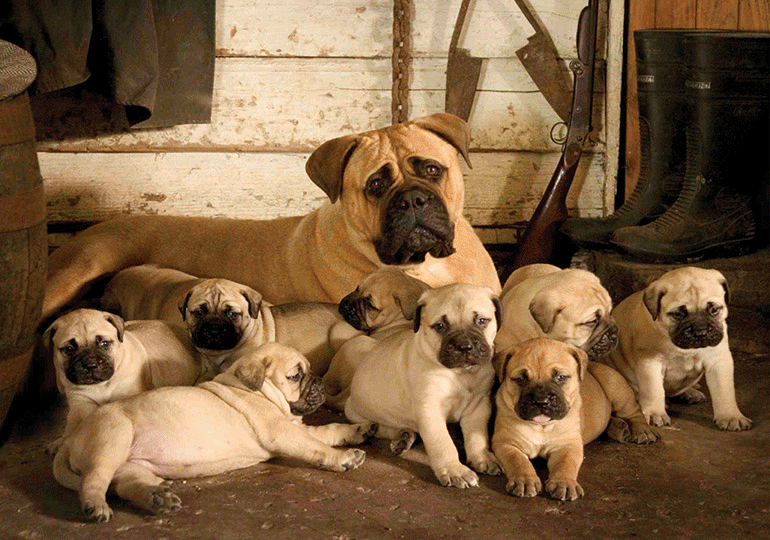
GROUP 6 - UTILITY
Bred by English gamekeepers in the 1800s, to assist wardens or gamekeepers by guarding their estates, the Bullmastiff is known as the gamekeepers’ night dog. Originally, it was bred from the old English Bulldog (not the short, stocky Bulldog of today) and the English Mastiff. This ancestry produced a powerful, enduring, active and reliable dog. The Bullmastiff of today is also high spirited, intelligent, loyal, fearless and confident yet docile.
With their powerful build, Bullmastiffs show great strength. However, they are not cumbersome, and appear healthy and active. There are three main colours, fawn, red and brindle, ranging in any shade, and a slight white marking on the chest is permissible.
Bullmastiffs have large, square heads, with fair wrinkle when interested. They have dark or hazel eyes of medium size, and their strong, well arched necks are equal to their skulls in circumference.
Demeanour hints at great strength, immense determination, considerable self assurance, yet tractability. His whole manner should announce that he is sound in mind and body, and has the physical and mental attributes to make him always ready for action as a working dog. (1)
SIZE
Dogs: 64 – 69 cms (25 – 27 ins) at shoulder (withers)
Bitches: 61 – 66 cms (24 – 26 ins) at shoulder (withers)
WEIGHT
Dogs: 50 – 59 kg (110 – 130 lbs)
Bitches: 41 – 50 kg (90 – 110 lbs)
A seasonal coat changes a couple of times a year, (is short and dense), provides good weather protection and is very low maintenance. In high humidity, however, owners need to check the skin for hot spots. They are commonly found in areas where heat and moisture build up, such as around the base of the tail and under the body, but can appear anywhere, including the neck and ears.
Very little exercise is needed for the first 12 months; in fact, too much exercise in that period can damage rapidly growing joints and ligaments.
Exercise should take place early morning or late evening when it’s cool, as Bullmastiffs can be affected by the heat of the day
High-spirited but good natured, he takes a lively interest in all that is going on. Eager for fun with friends and family, yet alert to his surroundings, with the ability to discern between acceptable human behaviour and that warranting suspicion. (2)
Responsible breeders are doing their best to screen out health issues in their breeding programs, including developmental bone diseases that can affect puppies of rapidly growing large breeds, such as hypertrophic osteodystrophy, osteochondritis dissecans, and panosteitis.
Bullmastiffs have also been known to be affected by entropion, where the eyelid rolls inward, causing eyelashes and hair to rub against the cornea, as well as hip and elbow dysplasia.
Registered breeders are committed to minimising the risks of these conditions affecting their litters and therefore lowering the incidence of the conditions across the breed.
At home, in almost any situation, Bullmastiffs are also fine with children once they know them, and as long as the children have been taught how to behave around a dog and respect the dog. As with any dog of any breed, adult supervision is always best.
Words: Aimee Whitaker
References: 1. & 2. ANKC Extended Breed Standards
Image 1: Bullmastiff and pups -Trevor Phillips Photography
Image 2: (Head shot) - photo submitted by Brooke Turner and Glenn Sparham
Image 3: (Bullmastiff standing) - photo submitted by Vicki Brzekniak
Now you know a little about the Bullmastiff you may have think that this is the dog for you. Before you make a decision, please make contact with the breed club or your State controlling body for purebred dogs. They will be able to give you information about available puppies and also suggest dog shows where you can see the breed and speak to breeders. In this way you will gain a better perspective of the Bullmastiff and its needs and whether this breed would suit your lifestyle.
